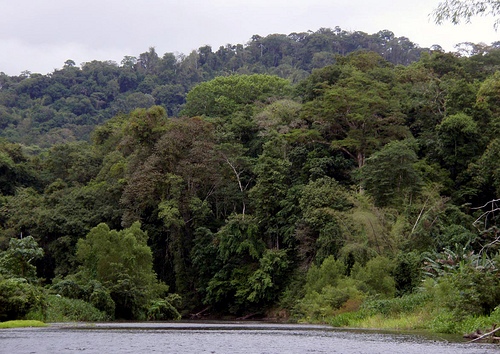

Location: Jinotega Department
Area: 20,000 km² (2 million ha)
The Bosawás Biosphere Reserve is located in the department of
Jinotega (border with Honduras), shared by the Autonomous Region of
the North Caribbean Coast (RACCN) and in a small part by the
Department of Nueva Segovia in Nicaragua. It was declared a
Biosphere Reserve by Unesco in 1997. Its name derives from the names
"Bocay river, Saslaya hill, and Waspuk river. The first reservation
was founded in 1954.
It is the largest forest reserve in
Central America and the third largest in the world and is one of the
best examples of tropical rain forest and cloud forests in the
region, also encompassing areas of medium altitude up to 1650 m
which reaches its highest point Alto, the hill Saslaya, whose
surroundings have been declared a national park. Countless tributary
rivers of the Coco River pass through the reserve, highlighting the
Bocay River and the Waspuk River. Together with the Río Plátano
Biosphere Reserve (8000 km²) and other wooded areas in Honduras, it
forms a continuous block of tropical forest. Some 50,000 km² (30,000
in Honduras and 20,000 in the Bosawás reserve in Nicaragua), which
represent the second largest forest in the entire continent.
The core zone of Bosawás Biosphere Reserve is composed of the
territories located in the southern part of the middle course of the
Coco River, with an approximate area of 7441 km², mainly
comprising the region within the Bocay River, Saslaya Hill and
Waspuk River. The Buffer Zone (more than 12,000 km²) is bounded by
the administrative boundaries of the six adjacent municipalities
(Bonanza, Siuna, Waspam, Waslala, Wiwilí and Cuá-Bocay), which share
common borders with the designated Core Zone of the Reserve.
Bosawás Biosphere Reserve was declared as such in 1979, but due to the US intervention it was not followed up. In 1991, after the war ended, government began to investigate the reserve. In 1997 it was declared a Biosphere Reserve. Since 2000, many settlers have settled and are clearing the forest. In 2003, the government declared 6 indigenous territories in the core zone to prevent the felling of more trees. At that time, 21,000 indigenous people received the title of possession of 7% of the Nicaraguan territory. However illegal deforestation continues.
The climate of the southern
region of Honduras and the northern part of Nicaragua is conducive
to the development of umbrophilous mountain forests and tropical
forests in the lowlands. This is how this great forest mass is
developed, extremely rich in plant and animal species. In Bosawás,
the largest forest area is in the core zone and is made up of
equatorial forests and mountain jungles; However, in the buffer zone
the forest has been cut and burned in such a way that it reduced the
vegetation cover from 12,000 km² to about 3000 km² (including pine
forests), to which the 7800 km² of land must be added. virgin forest
of the core zone. In total the jungles and pine forests of the
reserve covered about 14,000 km², however last Hurricane Felix
destroyed part of the forest and the forest area has been reduced to
about 10 500 km². 270 plant species have been identified in Bosawás
Biosphere Reserve; many of which have nutritional, ornamental and
medicinal attributes.
Bosawás Biosphere Reserve is a point of
convergence of fauna of North and South America and has an enormous
richness in both invertebrate and vertebrate organisms. The
rainforest is the richest biome on the planet and it is estimated
that 13% of the known species are found in Bosawás. There is little
knowledge of the species that inhabit Bosawás. However, since
research began in virgin areas of the reserve, 200 species of
vertebrate and invertebrate animals have been found. The reserve has
numerically significant quetzal colonies in Mesoamerica. In
reference to the avifauna is present one of the largest eagles in
the world, the harpy eagle (Harpya harpija); likewise there is a
defined population of Scarlet Macaws (Ara macao). There are also the
main predators (puma and jaguar) and the largest herbivore in
Mesoamerica, the tapir or danto. The entomofauna is still quite
unexplored. The existence of 100,000 to 200,000 species of insects
is roughly estimated. Many species of mammals serve as food for the
indigenous people.
The human population, apart from the mestizo, is composed of Mayangna
and Miskito Indians and have been organized into six indigenous
territories:
Miskito Indian Tasbaika Kum (683.4 km2).
Kipla Sait
Tasbaika (1,073.7 km2).
Li Lamni Tasbaika Kum
Mayangna Sauni As
(1.668 km2).
Mayangna Sauni Bu (1,024.5 km2).
Mayangna Sauni Bas
(40.1 km2).
The mestizo population, a core area of the reserve
carrying out an agricultural and livestock activity that has its impact
on the ecosystem of it.
Bosawás is a threatened reserve. Since it is the second largest
tropical forest in America, it has multiple threats from people. Many
mestizos driven by poverty and hunger settle in Bosawás and cut down the
jungle. Deforestation is the main threat; about 2500 km2 have already
been deforested, this has undoubtedly led to the extinction of many
species that were new to science. The population surrounding the reserve
continues logging despite the opposition of the native Mayagnas.
Along with the deforestation are the aftermath of Hurricane Felix which
destroyed a large part of the Bosawás rainforest. About 200 km2
disappeared completely and the other 12 000 km2 that make up the buffer
zone have been affected to varying degrees. Fortunately, the core area
(the one with the highest biodiversity) was not affected.